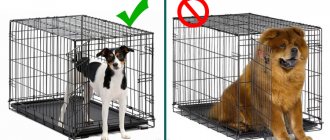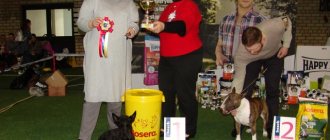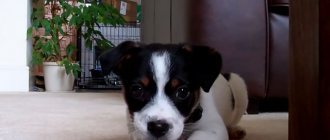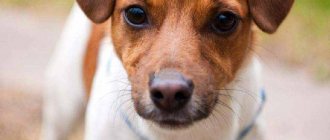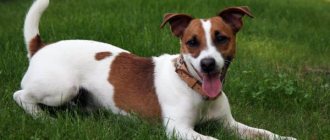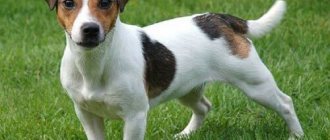Jack Russell Terriers are excellent hunters, loyal friends and big tomboys.
These little pets have captured the hearts of millions of people.
Every year the demand for these dogs only increases, but at the same time the number of scammers who sell mongrel dogs to people under the guise of Jack Russell Terriers is also growing.
In order not to encounter a similar situation, you need to know the breed standards.
Let's look into it in detail.
Basics of the standard
The Jack Russell Terrier breed standard includes the following features:
- appearance and proportions;
- movements;
- appointment;
- character;
- dimensions: weight and height;
- head;
- body type;
- forelimbs;
- hind limbs;
- wool cover;
- color;
- flaws;
- vices.
Many owners, in addition to the basic parameters of the standard, are interested in the questions of how old these dogs grow and how long they live. The final development of the dog occurs between ten and twelve months. The average lifespan of an animal is sixteen years. But how long a dog will live largely depends on the quality of care and education. You can read more about this in the article “Raising and caring for a Jack Russell Terrier puppy.”
Typical diseases of this breed
The health of a pet and its physical development greatly depend on the person, his attitude and conditions of detention. But the puppy’s heredity, vaccinations and the reputation of the breeders matter.
Among hereditary diseases there are:
- displacement of the eye lens
- progressive retinal atrophy
- ataxia - loss of coordination and loss of balance
- There are also cases of luxating the kneecap, von Willebrand disease and Legg-Calvé-Perthes disease.
Appearance
Active and resilient, the Jack Russell Terrier has a lithe, medium-length build and quick reflexes. For this expressive breed, having a heavy chest with undeveloped muscles is unacceptable.
A dog's coat has three types - smooth, hard and broken. The thick coat should be rough to the touch, but not too harsh, and should cope well with weather conditions.
At first glance at the rectangular body of the Jack Russell Terrier, it seems that the dog is growing in length, but not in height. From the chest to the withers of the animal there should be the same distance as from the elbow joint of the front paw to the ground. At the request of the dog owner, the tail can be docked, that is, some part can be removed.
Movements
The working characteristics of the breed allow the dog to move energetically and quickly. The Jack Russell Terrier's gait should feel free and confident. Due to its low weight and height, the dog can easily overcome obstacles.
Compliance with the standard can be determined when the dog walks without a leash. All movements of the Jack Russell Terrier should be natural and relaxed.
Advantages and disadvantages
The mini breed has a huge number of advantages: they fit perfectly into any family; love long walks; get along with children; despite their small size, they are considered excellent guards; are trainable and remember a lot of commands; do not require much care; do not have a specific odor characteristic of dogs; wool does not cause allergic reactions.
Despite all the positive features, the breed has several negative aspects: dogs are not intended to live on the street, they require a lot of attention, and often bark, which is annoying especially in an apartment.
Related article: Is it possible to take a Jack Russell Terrier with you on a hunt?
Character
Discerning, cheerful and highly intelligent, the Jack Russell Terrier has a bold and energetic personality. Thanks to its bright features, this dog is easy to train. The education of this dog must begin from an early age, otherwise the animal’s stubbornness and aggressiveness may take over. It is necessary to be able to restrain the dog’s persistence so that he can learn to control himself.
Dimensions
The height of a male Jack Russell Terrier should ideally be twenty-five to thirty centimeters; The minimum weight after the final development of the dog is five kilograms. An adult dog weighs no more than six kilograms.
The height of a female Jack Russell Terrier should be twenty-three to twenty-six centimeters, and its weight should also be up to six kilograms.
Calculating how much a dog weighs is very simple: for one kilogram of weight there are five centimeters of height. Accordingly, if an animal’s height is twenty-five centimeters, then its weight is five kilograms. If a dog is thirty centimeters tall, then its weight will be six kilograms.
Head
According to the standard, a dog's skull of medium length should be flat, gradually tapering to powerful jaws. The transition from the muzzle to the forehead is well defined, but not too clearly defined.
The nose is black.
The Jack Russell Terrier's muzzle should look like this: the length from the stop to the back of the head with a characteristic bump should be slightly longer than the length from the nose to the stop. The proportion is five to two.
The dog's lips fit tightly to the muzzle with black pigmentation.
The dog's cheekbones should have well-developed muscles.
A scissor bite of a strong, wide, square jaw has a full set of powerful, healthy teeth. Teeth damaged as a result of hunting are not considered a defect and such a dog should not be fined. But a protruding jaw with poorly developed muscles is a defect.
Small almond-shaped eyes with fully closed eyelids have a dark shade and a soulful look. A bulging eyeball is a defect.
The Jack Russell Terrier's mobile and strong ears can be drooping or slightly raised on cartilage. The dog can turn them one hundred and eighty degrees. Prick ears are considered a defect according to the standard.
Well-developed neck muscles allow the dog to hold its head balanced. The length of the strong neck should correspond to a two to three proportion relative to the back of the animal. The neck is responsible for the balance of the entire body, so a neck that is too powerful, short or long is a defect.
Body type
According to the standard, the Jack Russell Terrier's body should be rectangular in shape with a flat back. The length from withers to tail is slightly longer than from ground to withers.
The short loin has well-developed muscles, since the ribs of the chest cannot withstand heavy loads.
A deep chest should have a small volume. In the middle of the distance from the ground to the withers of the animal there should be a clearly visible part of the chest. The volume of the ribs behind the elbows of the forelimbs is forty to forty-three centimeters. If you look at the dog from above, the chest should be visible from behind the shoulder.
The tail hangs down in a calm state; when the Jack Russell Terrier is excited, it becomes straight and takes on a vertical position. If the animal's tail has been docked - some part has been removed - its end should be at the level of the ears.
How the whole process works
There are two methods for shortening the tail:
- cutting off;
- using compression.
Surgical method
In the first method, the tail part is separated with surgical scissors. The procedure takes no more than half an hour. This method is considered less humane, but safer. At a young puppy's age, it is performed without anesthesia. The technique is as follows:
- First, the specialist determines the cutting location. The fur in the amputation area is shaved clean at a distance of 2 cm on each side of the cut line.
- The skin in the prepared area is thoroughly disinfected.
- The pet is then securely fixed in a prone position. The tail at the base is tied with a bandage or thread.
- The doctor pulls the skin of the tail towards its base, creating a small fold.
- Then pruning is carried out.
- The skin fold diverges, closing the wound. In the case of an adult dog (over 6 months), 1-3 sutures are placed along the edge of the cutting line.
- The rehabilitation period after surgical reduction lasts about two weeks.
For an adult dog, the procedure is similar, but anesthesia will be required.
Animals older than 3 weeks are given local anesthesia. In the case of an older dog, general anesthesia will be used. Typically, veterinarians use inhaled alcohol-chloroform-ether anesthesia in combination with a neuroplegic (Rompun) and atropine sulfate.
Without surgery
This method is considered humane, since the tail is amputated without surgery. It is simply pulled along the cutting line with a tight elastic band for 2-7 days. Due to the lack of blood supply, the atrophied area disappears.
However, there is a high risk that when the tissue dies, an infection may enter the puppy’s blood. The result may be sepsis, suppuration and inflammation. Only after being recently born can a puppy die. When choosing an amputation method, carefully weigh the pros and cons.
At home
To carry out this important procedure, of course, it is better to involve an experienced veterinarian or breeder. But you can do cupping at home. For the first case, it is advisable to ask for help from a specialist, carefully observing and assisting at every stage.
Before the procedure, isolate the mother dog in a separate room so that she does not interfere with the operation. Prepare for cupping:
- sterile scissors;
- brilliant green, alcohol;
- sterile disposable diaper;
- waste bowl.
Also clean your hands and work surface.
Take puppies one at a time for the procedure. Let the rest wait in line in the “nest” with the bitch. This minimizes stress for both the babies and the mother.
The process is carried out in the following sequence:
- Take the puppy and place his tail to the one who docks the tail.
- The assistant must hold the dog so that the limbs and body are completely fixed.
- Measure the length, determine the cutting line.
- Disinfect the area with alcohol.
- Pull the skin towards the base of the tail as far as possible, holding it with your thumb and forefinger.
- Cut off the tip with a sharp movement.
- Treat the wound with brilliant green.
If everything went well, the cut site will heal within an hour and will not bleed. Otherwise, you should tie the tail with a thread at the base for 2-3 hours. Do the same with the rest of the puppies. Make sure that the puppies cannot bite each other's wounds.
Hind limbs
The Jack Russell Terrier's strong hind legs are well-muscled. They maintain balance in proportions relative to the shoulder blades.
The hock joint stands at a comfortable angle relative to the ground and is located quite low.
If you look at the dog from behind when it is standing calmly, you will see that the metatarsus are parallel to each other.
Small, densely built, hind legs have soft pads. Toes turned inward or outward are considered a flaw.
Owner reviews
Ivan Semenov (Vladimir)
Previously, hunting dogs had their tails docked so that they would not interfere with chasing the animal or pulling it out of holes, and there was no doubt about it. Now, too, those who hunt have their tails and ears cut off. And if the dog is only for exhibitions, then you don’t need to trim it. Why torture the dog again?
Tatiana Pasternak (st. Raevskaya)
Our Grantik is only at home, no hunting or exhibitions. Therefore, we see no reason to dock his tail. But the breeder from whom we took the puppy immediately asked us whether we needed to crop the ears and tail. As I understand it, if the buyer needs it, she will organize this procedure herself while the puppies are very small.
Vitaly Vladimirovich (Moscow)
My Jack Russell Pancho and I attend almost all exhibitions. The tail was docked as expected - on the 3rd day after birth. I don't regret it. You never know exactly how it will be - stand or lie, or maybe even spin into a ring? And for a show dog this is important.
